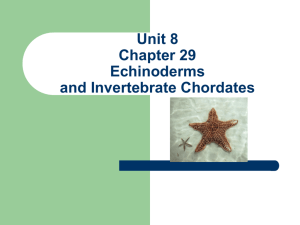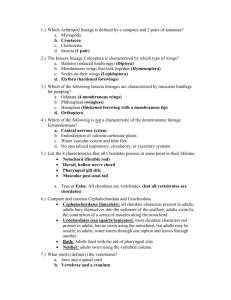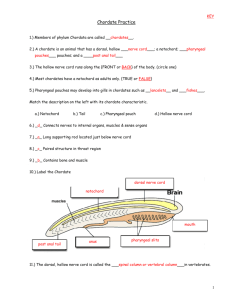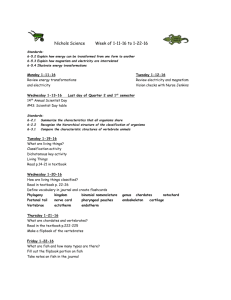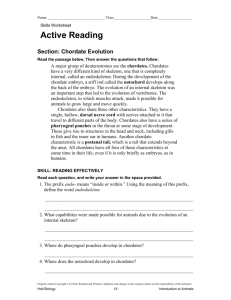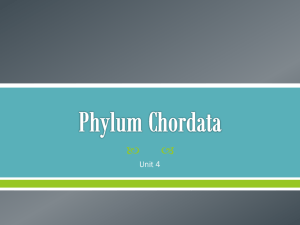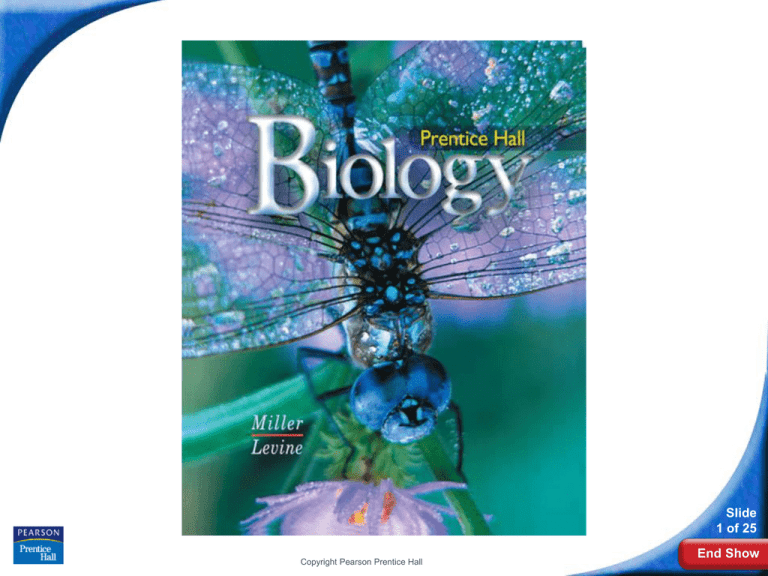
Biology
Slide
1 of 25
Copyright Pearson Prentice Hall
End Show
30-1 The Chordates
Slide
2 of 25
Copyright Pearson Prentice Hall
End Show
30-1 The Chordates
What Is a Chordate?
What Is a Chordate?
Members of the phylum Chordata are called
chordates.
A chordate is an animal that has, for at
least some stage of its life, a dorsal,
hollow nerve cord; a notochord;
pharyngeal pouches; and a tail that
extends beyond the anus.
Slide
3 of 25
Copyright Pearson Prentice Hall
End Show
30-1 The Chordates
What Is a Chordate?
Characteristics of Chordates
Muscle segments
Tail
Anus
Notochord
Hollow nerve cord
Mouth
Pharyngeal pouches
Slide
4 of 25
Copyright Pearson Prentice Hall
End Show
30-1 The Chordates
What Is a Chordate?
The notochord is a long supporting rod that runs
through the body just below the nerve cord.
Notochord
Slide
5 of 25
Copyright Pearson Prentice Hall
End Show
30-1 The Chordates
What Is a Chordate?
Pharyngeal pouches are paired structures in the
throat (pharynx) region.
Pharyngeal pouches
Slide
6 of 25
Copyright Pearson Prentice Hall
End Show
30-1 The Chordates
What Is a Chordate?
The tail can contain bone and muscle and is used for
swimming by many aquatic species.
Tail
Slide
7 of 25
Copyright Pearson Prentice Hall
End Show
30-1 The Chordates
What Is a Chordate?
Most Chordates Are Vertebrates
About 96 percent of all chordate species are
vertebrates.
Most vertebrates have a vertebral column, or
backbone.
In vertebrates, the dorsal, hollow nerve cord is
called the spinal cord.
Slide
8 of 25
Copyright Pearson Prentice Hall
End Show
30-1 The Chordates
What Is a Chordate?
Phylogeny of Chordates
Sharks
& their
Jawless
relatives
fishes
Nonvertebrate
chordates
Bony
fishes
Reptiles Birds
Amphibians
Mammals
Invertebrate ancestor
Slide
9 of 25
Copyright Pearson Prentice Hall
End Show
30-1
Click to Launch:
Continue to:
- or -
Slide
10 of 25
End Show
Copyright Pearson Prentice Hall
30-1
A characteristic of most, but not all, chordates is
a. pharyngeal pouches.
b. a backbone.
c. a hollow nerve cord.
d. a tail that extends beyond the anus.
Slide
11 of 25
End Show
Copyright Pearson Prentice Hall
30-1
In vertebrates, the developing backbone
replaces the
a. pharyngeal pouches.
b. hollow nerve cord.
c. notochord.
d. siphon and tunic.
Slide
12 of 25
End Show
Copyright Pearson Prentice Hall
END OF SECTION

